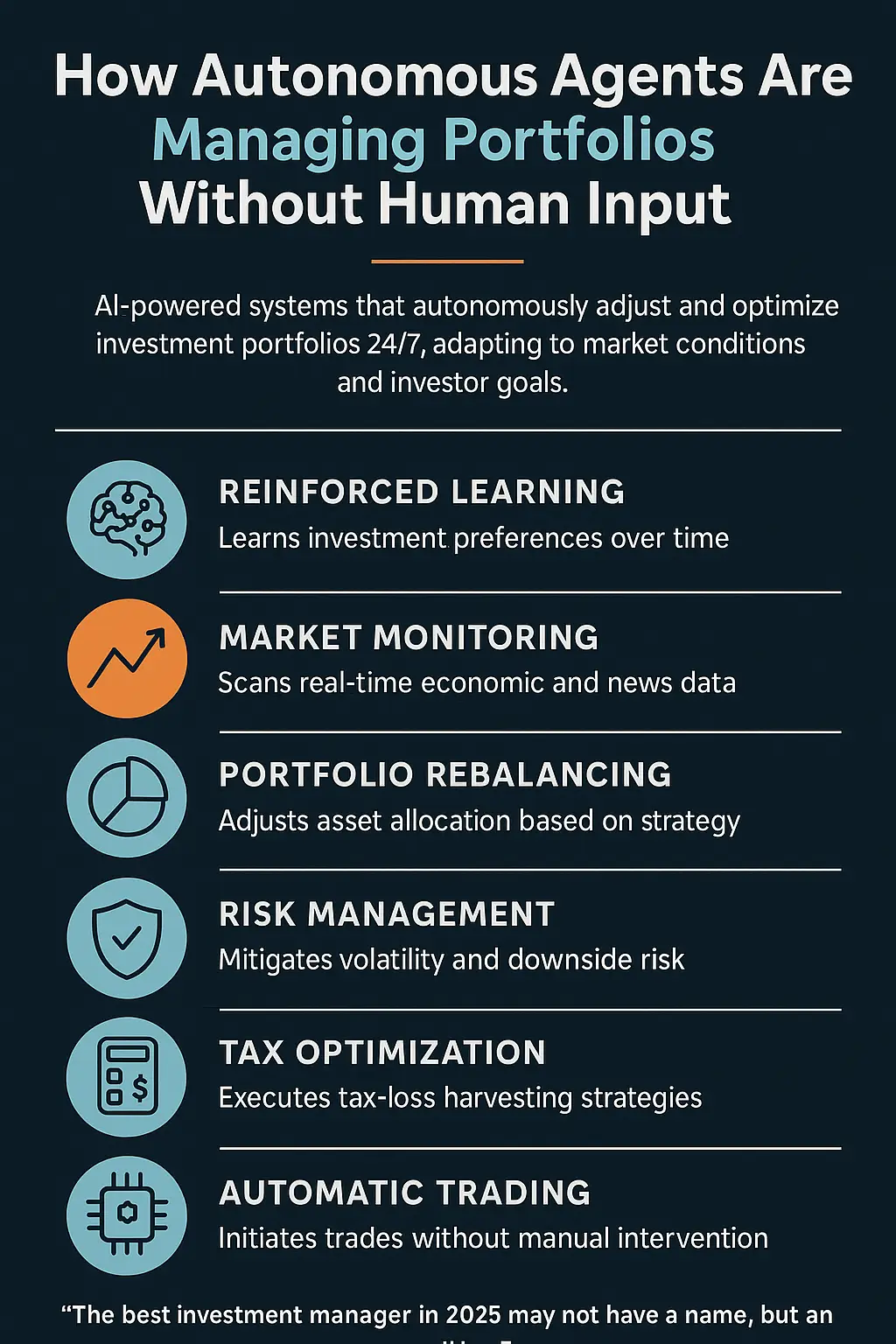🧠 How Autonomous Agents Are Managing Portfolios Without Human Input
In today’s fast-paced, data-saturated markets, timing is everything—and trust in traditional human-driven investment strategies is being redefined. A new class of intelligent systems is taking the reins: autonomous agents that manage portfolios without ongoing human intervention.
These systems don’t just react—they anticipate. They don’t wait for a portfolio manager’s Monday morning strategy call—they operate 24/7, analyzing, adjusting, and optimizing investments based on real-time signals.
Welcome to the age of self-directed AI portfolio management.
🤖 What Are Autonomous Agents in Finance?
An autonomous agent in finance is an AI-powered system that can:
- Set and pursue investment goals
- Monitor thousands of data points in real time
- Make asset allocation decisions based on learned preferences
- Execute trades without manual approval
- Continually refine its strategy through feedback
Unlike traditional robo-advisors that follow pre-programmed models, autonomous agents learn from the market and adapt as conditions change.
🔍 Why They’re Gaining Traction in 2025
Several converging trends are accelerating the shift toward autonomous agents:
- 📉 Market volatility makes static models obsolete
- ⚡ Real-time data availability from news, APIs, and social media
- 🧠 Advances in reinforcement learning and agentic AI
- 🧾 Retail investor demand for faster, smarter investment tools
The result is a new generation of “hands-free” investing—no spreadsheets, no rebalancing schedules, no human bottlenecks.
🧭 How It Works: A Day in the Life of an Autonomous Portfolio Agent
Here’s what such an agent might do in a single day:
| Time | Action |
|---|---|
| 06:00 | Pulls overnight market data and adjusts asset weightings based on Asian market volatility |
| 08:30 | Reads Fed chair speech transcript using NLP and updates U.S. bond exposure |
| 11:00 | Detects rising sentiment for tech stocks via social media feeds and buys call options |
| 14:45 | Triggers automatic tax-loss harvesting on underperforming assets |
| 19:00 | Re-evaluates client goals and rebalances toward conservative allocations due to aging profile |
💡 All of this happens without the investor lifting a finger.
📊 Real-World Applications
- Wealthfront and Betterment are beginning to incorporate autonomous elements in rebalancing and tax strategies.
- Hedge funds are using AI agents for high-frequency trades based on sentiment and momentum.
- Retail apps are experimenting with agents that align spending, saving, and investing with user behavior.
✅ Benefits of Autonomous Portfolio Agents
| Benefit | Description |
|---|---|
| ⏱️ Speed | Acts in milliseconds—much faster than human managers |
| 🔄 Adaptability | Adjusts instantly to news, earnings, and economic changes |
| 🧮 Discipline | Removes emotional bias and human error |
| 🪙 Efficiency | Optimizes fees, taxes, and time—simultaneously |
⚠️ Risks and Ethical Considerations
- Over-optimization: Agents might exploit short-term gains at the cost of long-term stability.
- Transparency: Investors may not understand how decisions are made.
- Data dependency: Garbage in, garbage out—bad data leads to bad decisions.
- Regulatory compliance: Autonomous trades must meet existing rules on disclosure and suitability.
👁️ “Explainable AI” will be a critical feature for regulators and investors alike.
🌍 What This Means for Investors
Autonomous agents won’t eliminate human advisors—but they will shift the role from decision-maker to strategic overseer. Expect:
- Hybrid models, where humans and AI co-manage capital
- Agent marketplaces, letting investors choose between strategies
- Goal-driven investing, where AI agents manage toward specific life milestones, not just returns
“The best investment manager in 2025 may not have a name, but an algorithm.”

